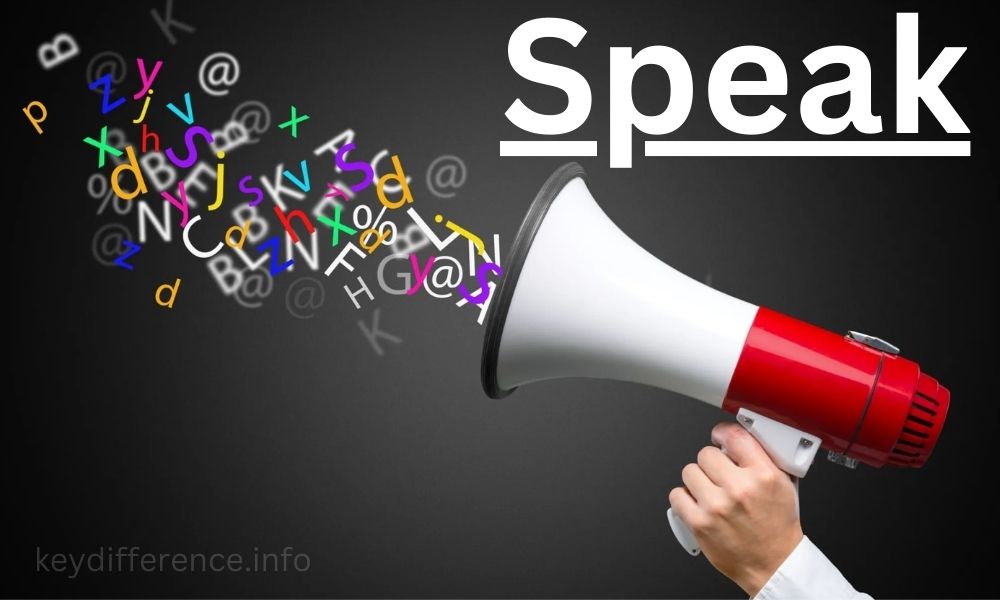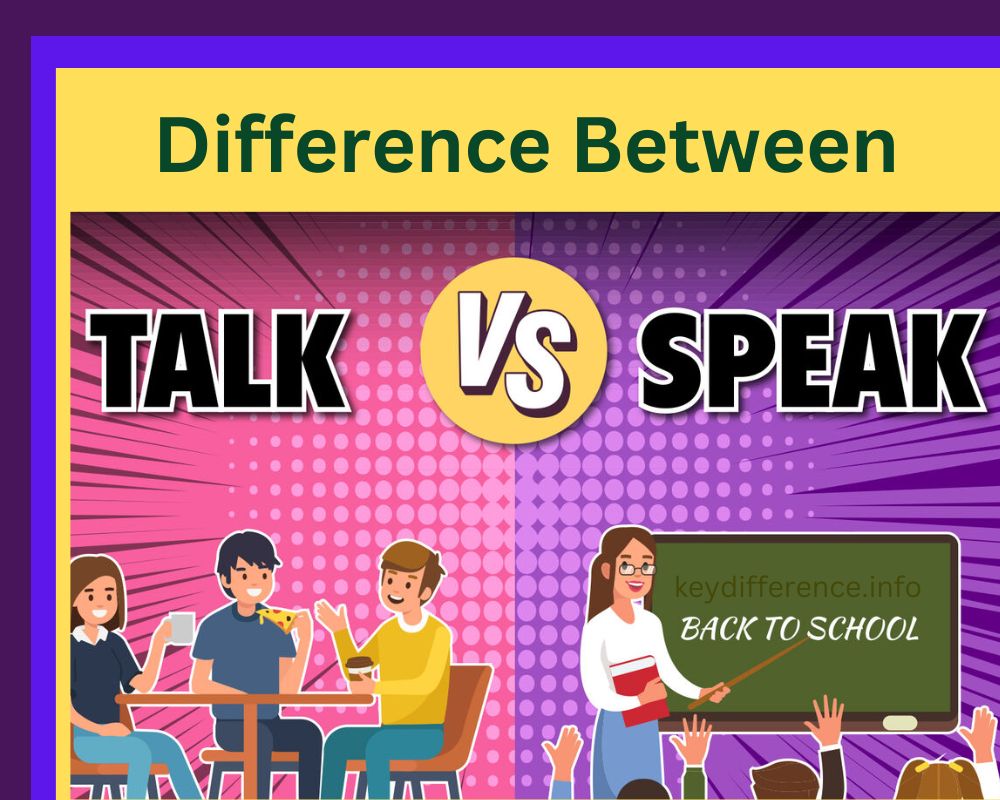Introduction to Speak and Talk
Speak and Talk are integral to effective communication. Although used interchangeably, they each possess distinct features and serve different functions.
Understanding the differences between talking and speaking can improve our communication abilities and facilitate engagement with others more efficiently. This content outline explores these distinctions between talking and talking; its definition, key features and applications to specific situations as well as why both abilities should be developed simultaneously.
Understanding the significance of different forms of communication will enable you to appreciate its role in various spheres of your life.
What is Speak?

Speaking refers to the act of expressing thoughts, ideas, or information using verbal communication. It involves using words, sentences, and language to convey a message to an audience. Speaking typically occurs in formal or structured settings where there is a specific purpose or intention behind the communication.
Key characteristics and features of speaking
- Verbal expression: Speaking involves using spoken words to articulate thoughts and ideas.
- Delivery: It requires clarity, proper enunciation, and effective use of tone, pitch, and volume to convey meaning.
- Audience-focused: Speaking often involves addressing an audience or listeners, with the goal of conveying information, persuading, or entertaining them.
- Preparedness: In many instances, speaking requires prior planning, organization, and rehearsal to ensure a coherent and impactful delivery.
Examples of speaking situations
- Public speaking: Delivering a speech or presentation in front of a large audience.
- Formal presentations: Presenting information or reports in a structured manner to colleagues, clients, or superiors.
- Lectures and seminars: Engaging in educational or instructional speaking to share knowledge or expertise with students or participants.
Skills required for effective speaking
- Clarity and articulation: The ability to pronounce words clearly and express ideas in a manner that is easily understood.
- Tone and volume control: Using appropriate tone and volume to convey emotions, emphasize key points, and maintain audience engagement.
- Body language and non-verbal cues: Utilizing gestures, facial expressions, and body posture to enhance communication and establish rapport with the audience.
- Confidence and poise: Developing self-assurance and composure while speaking in front of others.
By understanding the characteristics, situations, and skills associated with speaking, individuals can improve their ability to effectively communicate ideas, information, and messages in various professional and public contexts.
What is Talk?

Talking refers to the interactive exchange of ideas, opinions, or information between individuals through verbal communication. It is a more informal and conversational form of communication that takes place in everyday interactions, where the primary focus is on building relationships, sharing thoughts, and engaging in dialogue.
Key characteristics and features of talking:
- Interactive communication: Talking involves a back-and-forth exchange between two or more individuals, with each participant actively contributing to the conversation.
- Informal nature: Unlike speaking, talking is less structured and often takes place in casual settings or personal interactions.
- Relationship-building: Talking is an essential tool for connecting with others, establishing rapport, and fostering understanding.
- Spontaneity: Conversations typically unfold naturally and are not extensively planned or rehearsed.
Examples of talking situations:
- Casual conversations: Engaging in informal chats with friends, family, or colleagues on various topics of interest or everyday experiences.
- Informal discussions: Participating in group discussions or small talk during social gatherings or networking events.
- Everyday interactions: Interacting with individuals in day-to-day life, such as interacting with store clerks, neighbors, or acquaintances.
Skills required for effective talking:
- Active listening: The ability to attentively listen to others, demonstrate interest, and provide appropriate responses.
- Responding and engaging in dialogue: Being able to contribute to the conversation by sharing thoughts, asking questions, and expressing opinions.
- Empathy and understanding: Showing empathy towards others, understanding their perspectives, and creating a supportive conversational environment.
Developing strong talking skills allows individuals to engage in meaningful conversations, establish connections, and foster effective interpersonal relationships. It enables individuals to express their thoughts, actively listen to others, and contribute to discussions in a manner that promotes understanding and mutual respect.
Similarities between Speak and Talk
Although Speak and Talk have distinct characteristics and purposes, they also share some commonalities in the realm of communication.
Here are a few key similarities between Speak and Talk:
- Verbal Communication: Both Speak and Talk involves the use of verbal language to express thoughts, ideas, and information. They rely on spoken words as the primary means of communication.
- Language and Vocabulary: Both Speak and Talk require a command of language and vocabulary to effectively convey messages. Whether in a formal speech or a casual conversation, the choice of words and linguistic proficiency are important for clarity and understanding.
- Exchange of Information: Both speaking and talking facilitate the exchange of information and ideas between individuals. Whether it’s delivering a presentation or engaging in a conversation, the goal is to share and receive information.
- Interaction: Both speaking and talking involve interaction between individuals. While speaking often involves addressing an audience or a group, talking involves a more intimate and interactive conversation between two or more people.
- Communication Skills: Both speaking and talking require certain communication skills to be effective. These skills include clarity of expression, active listening, engaging in dialogue, and adapting to the needs of the audience or conversation partners.
- Social Engagement: Both speaking and talking serve as social activities, allowing individuals to connect, engage, and establish relationships with others. They contribute to social cohesion, understanding, and the development of interpersonal connections.
While Speak and Talk have their differences, recognizing their shared elements highlights the importance of effective communication in various contexts. Developing proficiency in both skills can lead to better understanding, meaningful connections, and successful interactions with others.
Differences between Speak and Talk
Here are a few key Difference Between Speak and Talk:
Contextual differences
Formal vs. informal settings:
- Speaking is more commonly associated with formal settings such as conferences, presentations, or public speaking events.
- Talking is typically associated with informal settings like casual conversations, social gatherings, or everyday interactions.
Professional vs. personal interactions:
- Speaking is often used in professional or business-related contexts, where communication is focused on conveying information, persuading, or educating.
- Talking is more commonly used in personal interactions, where communication is aimed at building relationships, sharing opinions, or engaging in social exchanges.
Purpose and intent
Conveying information vs. building relationships:
- Speaking is primarily used to convey information, deliver a message, or present ideas to an audience.
- Talking is more focused on building relationships, establishing connections, and fostering interpersonal communication.
Imparting knowledge vs. sharing opinions:
- Speaking often involves sharing structured knowledge or expertise on a specific topic.
- Talking involves sharing personal opinions, thoughts, and experiences in a more conversational manner.
Speaking skills vs. conversational skills
Emphasis on delivery and presentation:
- Speaking places emphasis on effective delivery, including clarity, tone, and body language, to engage and captivate an audience.
- Talking emphasizes conversational skills such as active listening, responding, and maintaining a natural flow of dialogue.
Focus on active listening and responsiveness:
- Speaking typically involves minimal audience participation, with the speaker taking the central role.
- Talking requires active listening, reciprocal engagement, and responsiveness from all participants involved in the conversation.
Structure and length
Planned and structured speeches vs. spontaneous conversations:
- Speaking often involves prepared speeches or presentations with a clear structure and predefined content.
- Talking is more spontaneous and flexible, with conversations evolving naturally based on the participants’ responses and interests.
Varied length and level of formality:
- Speaking engagements tend to have a specific time frame and follow a more formal style of communication.
- Talking can vary in length and formality, depending on the context, participants, and subject matter.
Understanding these differences between Speak and Talk enables individuals to adapt their communication style and approach according to the specific context, purpose, and audience. Both skills are valuable and contribute to effective communication in different settings, allowing individuals to express themselves, connect with others, and convey their messages appropriately.
Comparison Chart: speak and talk
Here’s a detailed comparison chart highlighting the differences between Speak and Talk:
| Aspect | Speak | Talk |
|---|---|---|
| Context | Formal or structured settings | Informal or casual settings |
| Purpose | Convey information, deliver a message | Build relationships, share opinions, engage in conversation |
| Delivery | Structured and planned delivery | Conversational style |
| Audience | Often addressing an audience | Interacting with one or more individuals |
| Preparedness | Requires planning, organization, and rehearsal | More spontaneous and flexible |
| Interaction | Minimal audience participation | Active interaction and engagement |
| Length and formality | Planned and structured speeches | Conversations of varied length and formality |
| Skills required | Clarity, articulation, body language | Active listening, responding, and empathy |
| Typical settings | Public speaking events, formal presentations | Casual conversations, social gatherings |
| Emphasis | Delivery and presentation skills | Conversational skills |
| Relationship-building | Less emphasis on relationship-building | Promotes relationship-building and connection |
| Knowledge imparted | Formal knowledge, structured information | Personal opinions, thoughts, experiences |
| Style | More formal and structured | Less formal and flexible |
| Purpose of communication | Conveying information, educating, persuading | Establishing connections, sharing ideas, understanding others |
How to remember the difference
To remember the difference between Speak and Talk, it can be helpful to focus on a few key points. Firstly, consider the context in which the communication occurs. Speaking is associated with formal settings, like presentations or public speaking while talking is more informal and happens in casual or personal interactions.
Secondly, think about the purpose of the communication. Speaking is about conveying information or delivering a message, whereas talking focuses on building relationships and engaging in conversation. Another distinction lies in the style of delivery. Speaking involves a structured approach, emphasizing clarity, tone, and body language to captivate an audience.
On the other hand, talking emphasizes conversational skills such as active listening and responding. Additionally, note the difference in preparedness and spontaneity. Speaking often requires preparation and rehearsal, whereas talking is more spontaneous and flexible.
Lastly, consider the length and formality. Speaking often has a set length and follows a formal style, while talking can vary in length and formality based on the context. By keeping these points in mind, you can better remember and understand the differences between speaking and talking.
Importance of Both Skills
Complementary nature of speaking and talking:
- Speak and Talk are complementary skills that together form a well-rounded communication repertoire.
- While speaking is essential for formal presentations, public speaking, and conveying information, talking plays a crucial role in building relationships, fostering understanding, and engaging in meaningful conversations.
Role in effective communication:
- Effective speaking allows individuals to deliver clear messages, engage an audience, and create a memorable impact.
- Talking facilitates active listening, empathy, and the exchange of ideas, leading to improved understanding, collaboration, and stronger interpersonal connections.
Enhancing personal and professional relationships:
- Developing strong speaking skills enables individuals to effectively articulate their thoughts, ideas, and expertise, thereby enhancing professional credibility and success.
- Proficiency in talking helps individuals build rapport, establish trust, and foster positive relationships in personal and social interactions.
Impact on individual growth and development:
- Enhancing speaking skills boosts confidence, public speaking abilities, and presentation capabilities, opening doors to new opportunities and personal growth.
- Developing strong talking skills enhances active listening, empathy, and effective communication, leading to improved relationships, conflict resolution, and personal development.
Both Speak and Talk are integral components of effective communication. Mastering both skills allows individuals to adapt their communication approach based on the context, audience, and purpose, leading to better understanding, enhanced relationships, and personal growth.
By continually improving these skills, individuals can excel in various aspects of their personal and professional lives, making a positive impact on others and themselves.
Improve and develop both speaking and talking abilities
Improving and developing both Speak and Talk abilities can greatly enhance your communication skills. Here are some suggestions to help you improve in both areas:
Practice regularly
Dedicate time to practice Speak and Talk. Engage in conversations, participate in group discussions, and seek opportunities to speak publicly. The more you practice, the more comfortable and confident you will become.
Seek feedback
Ask for feedback from others on your speaking and talking skills. Listen to constructive criticism and make adjustments accordingly. Feedback can help you identify areas for improvement and refine your communication style.
Enhance vocal delivery
Work on your vocal delivery for speaking. Pay attention to your tone, pace, and volume. Practice using appropriate pauses, emphasis, and intonation to engage your audience and convey your message effectively.
Improve body language
Consider your body language while speaking. Maintain eye contact, use gestures and facial expressions to enhance your communication, and project confidence. Practice good posture and nonverbal cues that support your message.
Active listening
Develop strong listening skills to facilitate better conversations. Practice active listening by giving your full attention, maintaining eye contact, and asking clarifying questions. Show genuine interest in what others have to say and be present in the conversation.
Expand vocabulary and language skills
Continually expand your vocabulary and improve your language skills. Read widely, engage in conversations with diverse individuals, and explore different topics. This will enable you to express yourself more precisely and eloquently.
Seek opportunities for public speaking
Look for opportunities to speak in public, such as joining a toastmasters club, presenting at meetings, or volunteering for speaking engagements. Public speaking experiences can boost your confidence, help you refine your delivery, and develop your ability to engage and connect with an audience.
Practice empathy and active engagement
Develop empathy and active engagement during conversations. Show genuine interest in others’ perspectives, ask thoughtful questions, and actively contribute to the dialogue. This helps build rapport and fosters meaningful connections.
Seek professional development
Consider attending workshops, seminars, or courses on public speaking and communication skills. These resources can provide valuable insights, techniques, and strategies for improving both your Speak and Talk abilities.
Record and review
Record yourself speaking or engaging in conversations, and then review the recordings to identify areas for improvement. Pay attention to your tone, clarity, and overall effectiveness. Take note of any habits or patterns that may detract from your communication and work on improving them.
Remember that developing Speak and Talk abilities is a continuous process. Embrace opportunities to practice and grow, and be patient with yourself. With consistent effort and a willingness to learn, you can improve and excel in both areas, becoming a confident and effective communicator.
How do we speak correct English?
Speaking correct English involves several key aspects that contribute to effective communication.
Here are some tips to help you speak English correctly:
- Grammar: Develop a solid understanding of English grammar rules, including verb tenses, sentence structure, subject-verb agreement, and word order. Regular practice and study of grammar will help you speak English more accurately.
- Vocabulary: Build a strong vocabulary by regularly learning new words and phrases. Read English books, newspapers, and magazines, and make use of vocabulary-building resources like flashcards or online tools. Increasing your vocabulary will allow you to express yourself more precisely and effectively.
- Pronunciation: Pay attention to pronunciation and practice speaking English aloud. Listen to native English speakers, watch English-language videos or movies, and imitate their pronunciation patterns. Regular practice will help you improve your pronunciation and sound more natural when speaking English.
- Listening skills: Develop your listening skills by actively listening to English conversations, podcasts, or audio materials. This will help you understand the correct pronunciation, intonation, and rhythm of the language. Practice listening to different accents and speech patterns to enhance your overall comprehension.
- Conversational practice: Engage in regular conversations with English speakers or language exchange partners. Practice speaking English in real-life situations and focus on fluency, clarity, and effective communication. Use the language actively and seek opportunities to practice speaking in various contexts.
- Seek feedback: Ask for feedback from native English speakers or language instructors. They can provide valuable insights on your pronunciation, grammar, and overall communication skills. Take their feedback constructively and work on areas that need improvement.
- Use resources and tools: Utilize English language-learning resources, such as grammar books, online tutorials, language apps, and language exchange platforms. These resources can provide guidance, exercises, and interactive tools to improve your speaking skills.
- Confidence and practice: Build confidence in your English speaking abilities by practicing regularly and pushing yourself to engage in conversations. Overcome the fear of making mistakes and focus on continuous improvement. Remember that making errors is a natural part of the learning process.
- Cultural awareness: Understand the cultural context behind English communication. Familiarize yourself with idioms, expressions, and cultural nuances to communicate more effectively and appropriately in English-speaking environments.
- Take language courses: Consider enrolling in English language courses or working with a language tutor who can provide structured guidance, personalized instruction, and opportunities for practice and feedback.
Remember, speaking correct English is a continuous learning process. Be patient, practice consistently, and embrace opportunities to use the language. Over time, your proficiency and confidence in speaking English will improve.
Advantages and Disadvantages of speak
Advantages of Speak
- Clarity and Organization: Speaking allows for careful preparation, structured delivery, and the ability to convey information or ideas in a clear and organized manner. This can enhance understanding and ensure that the message is effectively communicated.
- Influence and Persuasion: Speaking enables individuals to influence and persuade others. It provides the opportunity to engage an audience, use persuasive techniques, and deliver compelling arguments or presentations.
- Formal Settings: Speaking is often preferred in formal settings, such as public speaking events, presentations, or professional environments. It is particularly useful when conveying complex information or delivering formal speeches.
- Authority and Credibility: Speaking confidently and eloquently can enhance one’s perceived authority and credibility. Effective speaking skills can establish a positive impression and build trust among listeners.
Disadvantages of Speak
- Lack of Interactivity: Speaking can be a one-way communication process, with limited opportunities for immediate feedback or interaction from the audience. This can hinder the flow of information and limit the ability to address specific questions or concerns.
- Pressure and Nervousness: Public speaking or formal speaking engagements can induce anxiety and nervousness. The pressure to perform well and the fear of making mistakes may hinder effective communication and impact the speaker’s confidence.
Advantages and Disadvantages of talk
Advantages of Talk
- Engagement and Interaction: Talking promotes active engagement and interaction between individuals. It allows for real-time feedback, active listening, and the ability to respond and adapt to the conversation partner’s cues and needs.
- Relationship-building: Talking fosters personal connections and relationship-building. It enables individuals to express emotions, share personal experiences, and develop empathy and understanding with others.
- Flexibility and Spontaneity: Talking is more flexible and spontaneous compared to speaking. It allows for a free flow of ideas, thoughts, and opinions without the constraints of formal structure or delivery.
- Informal Settings: Talking is well-suited for informal settings, casual conversations, or social gatherings. It creates a relaxed atmosphere where individuals can freely express themselves without the pressure of formalities.
Disadvantages of Talk
- Lack of Structure: Talking may lack the structured organization of a formal speech or presentation. This can sometimes result in information being conveyed less clearly or concisely.
- Potential for Misunderstandings: Informal conversations may involve colloquial language, slang, or ambiguous expressions, leading to potential misunderstandings or misinterpretations.
- Informal Language Use: In casual conversations, there may be a tendency to use informal language, which may not be appropriate in certain professional or formal settings.
It’s important to note that the advantages and disadvantages of speaking and talking can vary depending on the context, purpose, and individual preferences. Both skills have their own merits and limitations, and developing proficiency in both can enhance overall communication abilities.
Which is better Speak or Talk?

The question of whether Speak and Talk is better depends on the specific context, purpose, and desired outcome of the communication. Both Speak and Talk have their own strengths and serve different purposes.
Speaking is often preferred in formal settings such as presentations, public speaking events, or professional environments where conveying information, delivering a message, or presenting ideas in a structured and organized manner is important.
Speaking allows for careful preparation, clear delivery, and the opportunity to engage and influence a larger audience. It is especially valuable when the goal is to educate, persuade, or inform.
On the other hand, talking is more suitable for informal or personal interactions. It focuses on building relationships, connecting with others, sharing opinions, and engaging in conversations. Talking allows for spontaneous and interactive exchanges, active listening, and empathetic understanding.
It is particularly effective in social settings, casual conversations, or when the primary objective is to foster connection, collaboration, or exchange of ideas.
Rather than considering one as inherently better than the other, it is more beneficial to recognize the strengths and purposes of both Speak and Talk. Developing proficiency in both skills enables individuals to adapt their communication style based on the specific context, audience, and desired outcome.
Being able to speak effectively and engage in meaningful conversations allows for a well-rounded communication repertoire and enhances overall communication skills.
Final thoughts on the significance of effective communication in various aspects of life
“Speak” and “talk” are both words that refer to the communication. “Speak” refers to the expression of concepts or words verbally and “talk” is a broader word that covers verbal communication, talks, or a casual discussion.
“Speak” usually implies more than just a formal, direct message in contrast “talk” can be casual or involve a variety of people. As a summary, “speak” is about communicating verbally. In contrast “talk” includes various forms of communication, which makes it a more flexible word for communicating.


